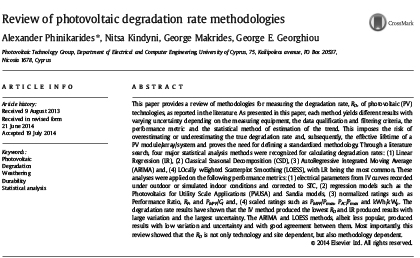The accurate and efficient evaluation of performance degradation of PV technologies is the next logical step to reaping the benefits of PV. as new. more efficient technologies emerge with unstudied and undefined durability and weatherability. Understanding of the performance degradation under real operating conditions is a key requirement for their successful characterization under varying meteorological conditions. The outcome of PV degradation assessments and the comparison of different PV technologies provide useful insight on the durability of each technology and their efficiency throughout their lifetime. In this paper it has been shown. from a number of published studies. that researchers are creating momentum with the degradation of PV and subsequently. their long-term durability. Through the analysis of published works. this review has shown that the degradation rate is not only technology dependent. but also methodology dependent. Many different methodologies for calculating degradation of different technologies were presented as well as their results in the form of degradation rates.
In the case of degradation rates and long-term durability. the recognized research directions are pointing towards the standardization of methods for degradation rate assessment including experimental uncertainty limits. measurement data qualification and filtering. averaging. outlier detection and performance rating techniques required in order to reduce uncertainty and variability and to establish the standardized reporting of degradation rates for different technologies. Finally. this review paper identified and presented the four major statistical analysis methods for the calculation of degradation rates: (1) Linear Regression (LR). (2) Classical Seasonal Decomposition (CSD). (3) AutoRegressive Integrated Moving Average (ARIMA) and. (4) LOcally wEighted Scatterplot Smoothing (LOESS) and the different performance metrics used in conjunction with these methods: (1) electrical parameters from IV curves recorded under outdoor or simulated indoor conditions and corrected to STC. (2) regression models such as the Photovoltaics for Utility Scale Applications (PVUSA) and Sandia models. (3) normalized ratings such as Performance Ratio. RP. and PMPP GI and. (4) scaled ratings such as PMPP Pmax. PAC Pmax and kWh kWp. A statistical analysis of the results of the methodologies has shown that the IV method with PE produced the lowest RD. The LR method produced results with considerable variations and uncertainty. The CSD method produced the highest RD for mono-c-Si and multi-c-Si but with lower uncertainty than LR. whereas the ARIMA and LOESS methods. albeit less popular. produced results with low variation and uncertainty and with good agreement between them for all technologies.
 Iran Energy News Oil, Gas, Petrochemical and Energy Field Specialized Channel
Iran Energy News Oil, Gas, Petrochemical and Energy Field Specialized Channel




